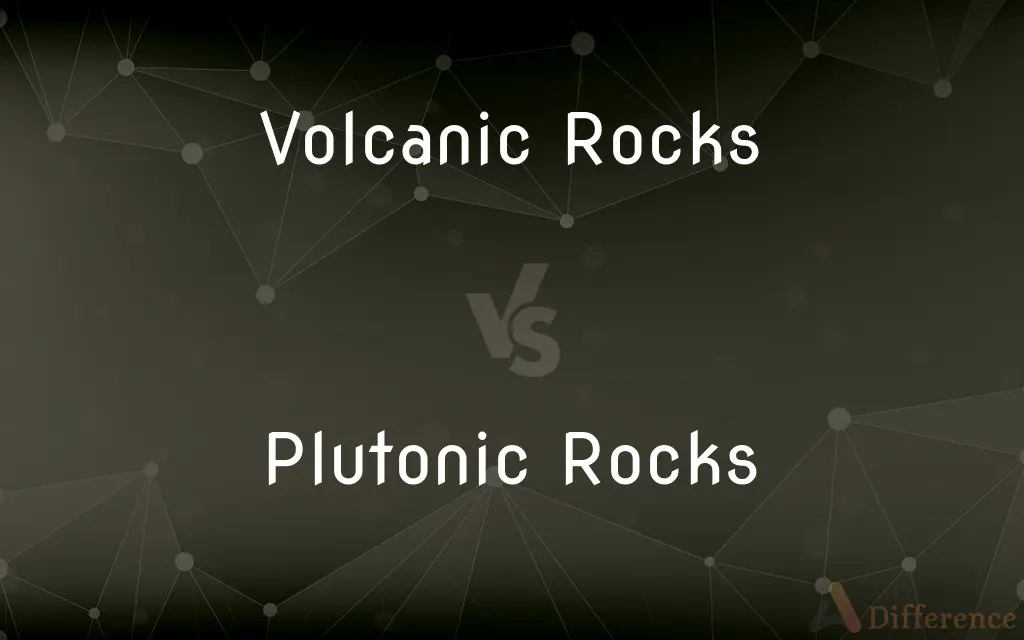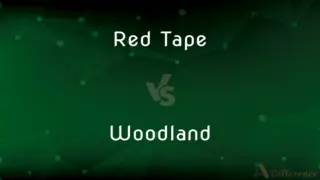Volcanic Rocks vs. Plutonic Rocks — What's the Difference?
By Tayyaba Rehman — Published on January 28, 2024
Volcanic Rocks form from lava that cools and solidifies on the Earth's surface. Plutonic Rocks, also known as intrusive igneous rocks, form from magma that cools slowly below the Earth's surface.

Difference Between Volcanic Rocks and Plutonic Rocks
Table of Contents
ADVERTISEMENT
Key Differences
Volcanic Rocks, also known as extrusive igneous rocks, originate from magma that erupts onto the Earth's surface and cools rapidly. Plutonic Rocks are formed deep within the Earth's crust from slowly cooled magma, resulting in a coarse-grained texture.
The rapid cooling of lava that leads to Volcanic Rocks often results in a fine-grained or glassy texture. In contrast, Plutonic Rocks, due to their slow cooling process, typically have larger, well-formed crystals.
Examples of Volcanic Rocks include basalt and pumice, which are common in volcanic areas. Common Plutonic Rocks include granite and gabbro, known for their use in construction and decoration.
Volcanic Rocks are often associated with volcanic activity and surface processes, like eruptions and lava flows. Plutonic Rocks, on the other hand, are associated with deep crustal processes and often exposed on the surface due to erosion.
In Volcanic Rocks, the mineral composition can be diverse, but they generally have less quartz compared to Plutonic Rocks. Plutonic Rocks, with their slower cooling, often contain a higher concentration of quartz and other minerals that form at higher temperatures.
ADVERTISEMENT
Comparison Chart
Formation Process
Cools and solidifies on Earth's surface
Cools slowly below Earth's surface
Texture
Fine-grained or glassy
Coarse-grained, larger crystals
Cooling Rate
Rapid cooling
Slow cooling
Common Examples
Basalt, pumice
Granite, gabbro
Associated Processes
Volcanic activity, surface eruptions
Deep crustal processes, erosion exposure
Compare with Definitions
Volcanic Rocks
Rocks formed from rapidly cooled lava on the Earth's surface.
The island's cliffs are composed of dark, fine-grained volcanic rocks.
Plutonic Rocks
Intrusive igneous rocks with coarse-grained textures.
The mountain range consists mainly of plutonic rocks like gabbro and diorite.
Volcanic Rocks
Extrusive igneous rocks formed from lava.
Volcanic rocks are often found near former lava flows and extinct volcanoes.
Plutonic Rocks
Rocks formed from slowly cooled magma beneath the Earth's surface.
Granite, a common plutonic rock, is widely used in kitchen countertops.
Volcanic Rocks
Rocks that solidify quickly at or near the Earth's surface.
Volcanic rocks like obsidian have a smooth, glassy texture due to rapid cooling.
Plutonic Rocks
Rocks characterized by larger, well-formed crystals.
Plutonic rocks, such as granite, are often polished for decorative purposes.
Volcanic Rocks
Igneous rocks with a fine-grained or glassy texture.
Pumice, a type of volcanic rock, is so light that it floats on water.
Plutonic Rocks
Rocks that form deep within the Earth's crust.
Plutonic rocks often reveal large crystals due to their slow cooling process.
Volcanic Rocks
Rocks typically formed during volcanic eruptions.
Basalt columns are a distinctive feature formed from cooled volcanic rocks.
Plutonic Rocks
Coarse-grained igneous rocks, typically rich in minerals.
The quarry extracts various types of plutonic rocks, including granite and syenite.
Common Curiosities
What is the typical texture of Volcanic Rocks?
They usually have a fine-grained or glassy texture.
What is the texture of Plutonic Rocks?
They are typically coarse-grained with larger, well-formed crystals.
Are Plutonic Rocks visible on the Earth’s surface?
Yes, they can be exposed on the surface due to erosion.
What are some examples of Volcanic Rocks?
Basalt and pumice are common examples.
What causes the formation of Volcanic Rocks?
They form from lava that cools and solidifies quickly on the Earth's surface.
Are Volcanic Rocks usually hard or soft?
They vary in hardness, but many, like basalt, are quite hard.
Is obsidian a Volcanic Rock?
Yes, obsidian is a type of volcanic glass.
How are Plutonic Rocks formed?
They form from magma that cools slowly deep beneath the Earth's surface.
Can Volcanic Rocks be found near all volcanoes?
Yes, they are commonly found in and around volcanic areas.
What are common uses of Plutonic Rocks like granite?
Granite is widely used in construction and for decorative purposes.
Do Volcanic Rocks cool quickly or slowly?
They cool quickly, often within a few days to years.
Do Plutonic Rocks have high mineral diversity?
Yes, they often contain a diverse range of minerals.
Is pumice a type of Volcanic Rock?
Yes, pumice is a light, porous volcanic rock.
Are Plutonic Rocks older than Volcanic Rocks?
They can be, as they form slowly over longer periods.
Can Plutonic Rocks be found in all geological areas?
They are widespread, but their exposure depends on geological history and erosion.
Share Your Discovery

Previous Comparison
DDA Algorithm vs. Bresenham’s Algorithm
Next Comparison
Red Tape vs. WoodlandAuthor Spotlight
Written by
Tayyaba RehmanTayyaba Rehman is a distinguished writer, currently serving as a primary contributor to askdifference.com. As a researcher in semantics and etymology, Tayyaba's passion for the complexity of languages and their distinctions has found a perfect home on the platform. Tayyaba delves into the intricacies of language, distinguishing between commonly confused words and phrases, thereby providing clarity for readers worldwide.
















































